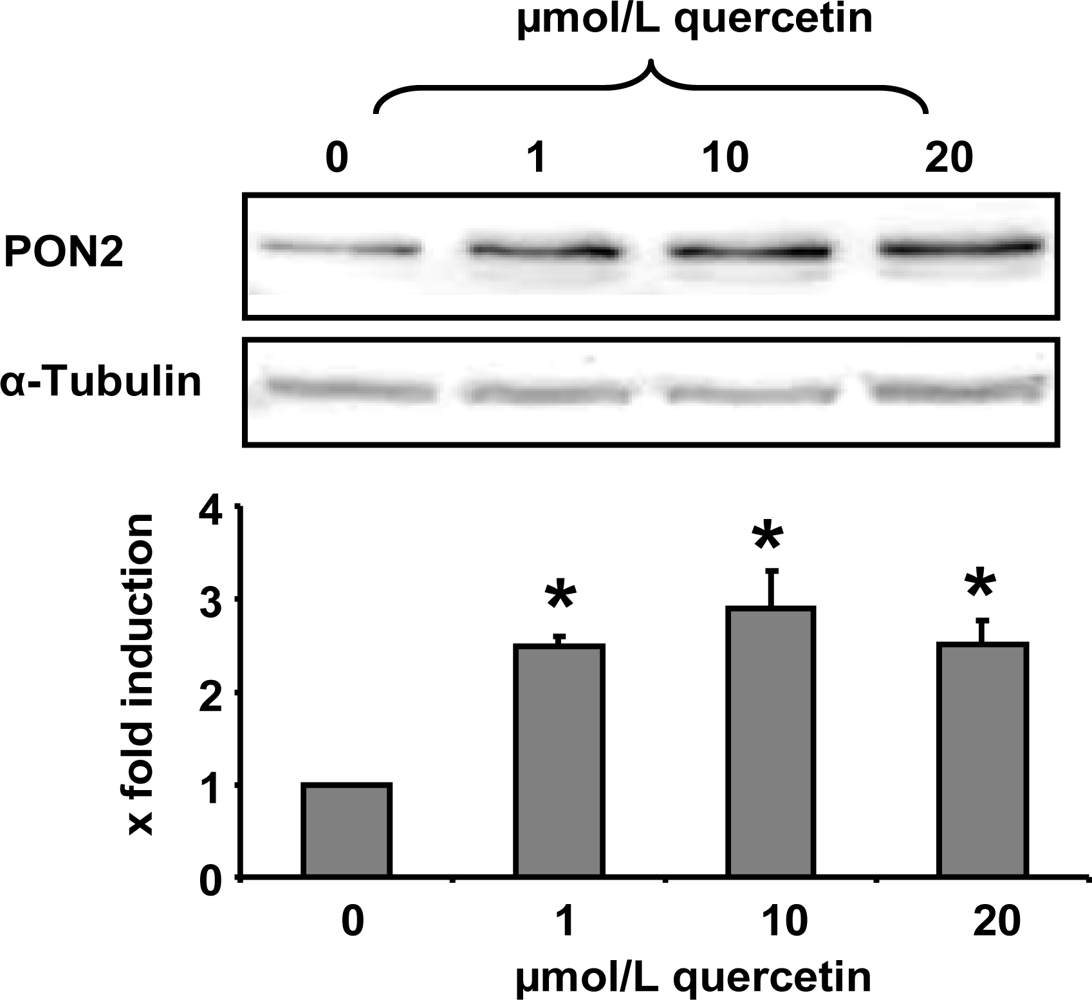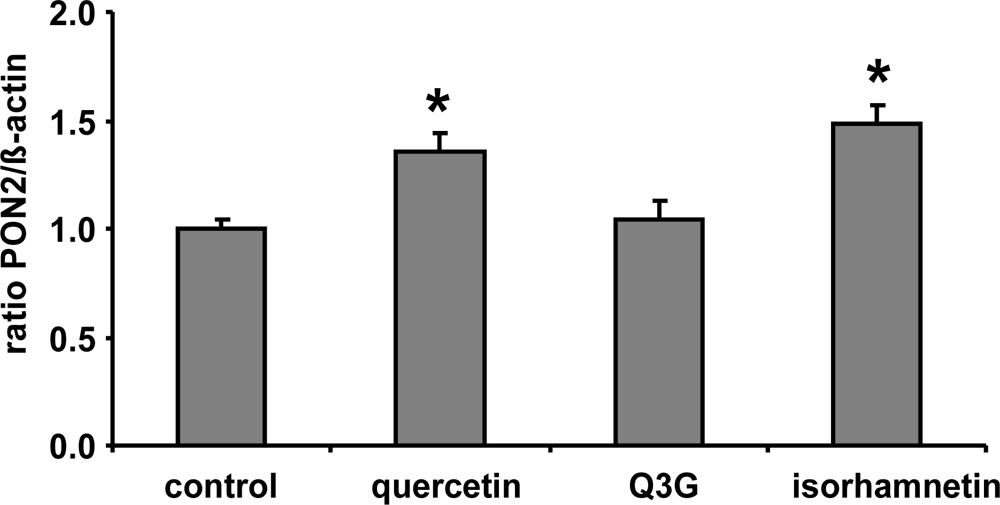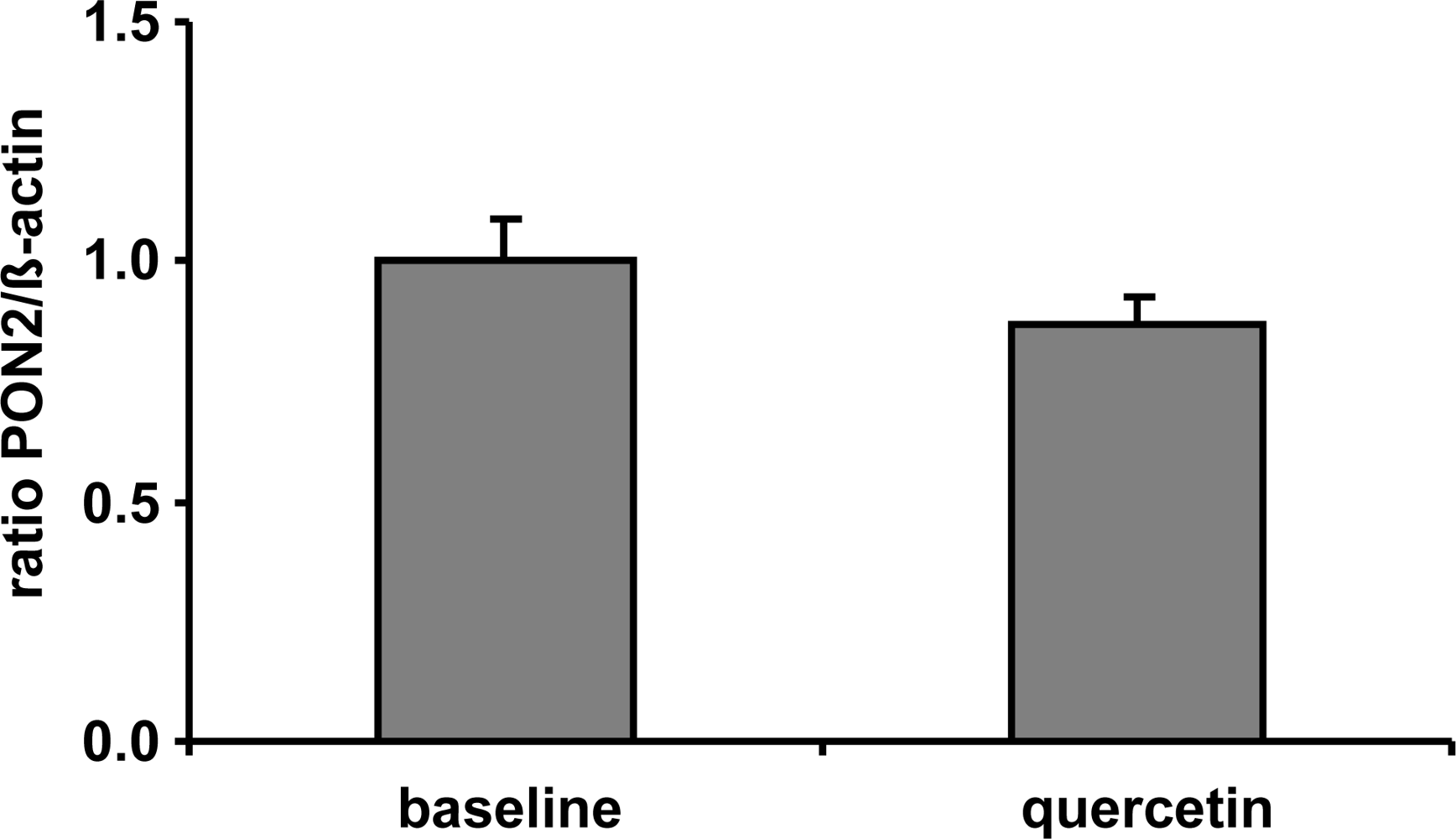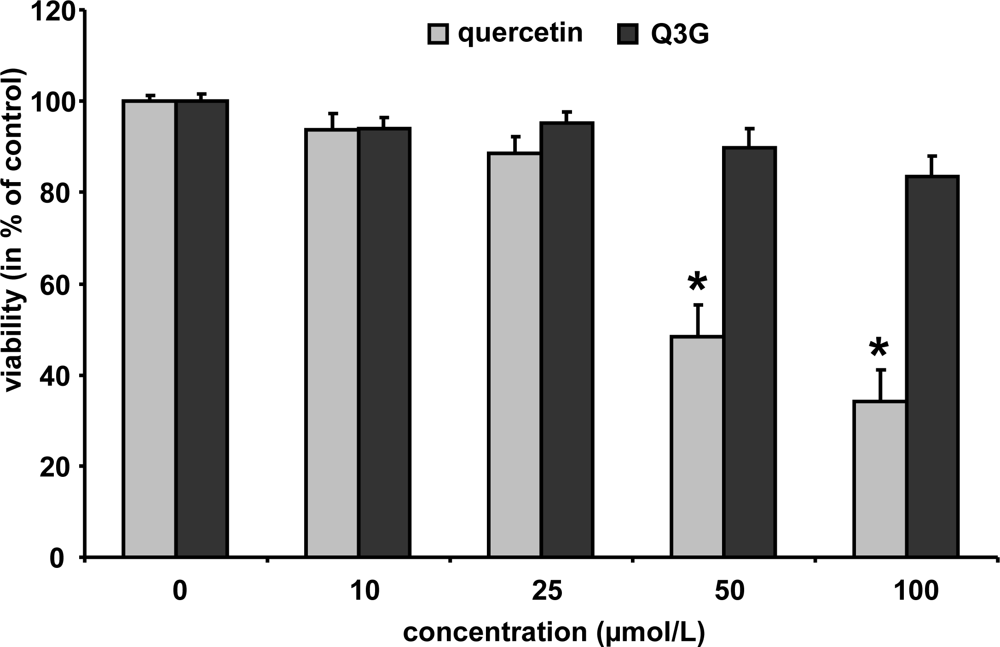Effect of Quercetin on Paraoxonase 2 Levels in RAW264.7 Macrophages and in Human Monocytes—Role of Quercetin Metabolism
Abstract
:1. Introduction
2. Results and Discussion
3. Experimental Section
3.1. Chemicals
3.2. Cell Culture and Treatments
3.3. Human Study
3.4. RNA Isolation and Real Time PCR
3.5. Western Blotting
3.6. Statistical Analysis
4. Conclusions
Acknowledgments
References and Notes
- Horke, S; Witte, I; Wilgenbus, P; Kruger, M; Strand, D; Forstermann, U. Paraoxonase-2 reduces oxidative stress in vascular cells and decreases endoplasmic reticulum stress-induced caspase activation. Circulation 2007, 115, 2055–2064. [Google Scholar]
- Ng, CJ; Wadleigh, DJ; Gangopadhyay, A; Hama, S; Grijalva, VR; Navab, M; Fogelman, AM; Reddy, ST. Paraoxonase-2 is a ubiquitously expressed protein with antioxidant properties and is capable of preventing cell-mediated oxidative modification of low density lipoprotein. J. Biol. Chem 2001, 276, 44444–44449. [Google Scholar]
- Rosenblat, M; Draganov, D; Watson, CE; Bisgaier, CL; La Du, BN; Aviram, M. Mouse macrophage paraoxonase 2 activity is increased whereas cellular paraoxonase 3 activity is decreased under oxidative stress. Arterioscler. Thromb. Vasc. Biol 2003, 23, 468–474. [Google Scholar]
- Aviram, M; Rosenblat, M. Paraoxonases 1, 2, and 3, oxidative stress, and macrophage foam cell formation during atherosclerosis development. Free Radic. Biol. Med 2004, 37, 1304–1316. [Google Scholar]
- Ng, CJ; Bourquard, N; Grijalva, V; Hama, S; Shih, DM; Navab, M; Fogelman, AM; Lusis, AJ; Young, S; Reddy, ST. Paraoxonase-2 deficiency aggravates atherosclerosis in mice despite lower apolipoprotein-B-containing lipoproteins: Anti-atherogenic role for paraoxonase-2. J. Biol. Chem 2006, 281, 29491–29500. [Google Scholar]
- Ng, CJ; Hama, SY; Bourquard, N; Navab, M; Reddy, ST. Adenovirus mediated expression of human paraoxonase 2 protects against the development of atherosclerosis in apolipoprotein E-deficient mice. Mol. Genet. Metab 2006, 89, 368–373. [Google Scholar]
- Rosenblat, M; Hayek, T; Hussein, K; Aviram, M. Decreased macrophage paraoxonase 2 expression in patients with hypercholesterolemia is the result of their increased cellular cholesterol content: Effect of atorvastatin therapy. Arterioscler. Thromb. Vasc. Biol 2004, 24, 175–180. [Google Scholar]
- Fortunato, G; Di Taranto, MD; Bracale, UM; Del Guercio, L; Carbone, F; Mazzaccara, C; Morgante, A; D’Armiento, FP; D’Armiento, M; Porcellini, M; Sacchetti, L; Bracale, G; Salvatore, F. Decreased paraoxonase-2 expression in human carotids during the progression of atherosclerosis. Arterioscler. Thromb. Vasc. Biol 2008, 28, 594–600. [Google Scholar]
- Egert, S; Wolffram, S; Bosy-Westphal, A; Boesch-Saadatmandi, C; Wagner, AE; Frank, J; Rimbach, G; Mueller, MJ. Daily quercetin supplementation dose-dependently increases plasma quercetin concentrations in healthy humans. J. Nutr 2008, 138, 1615–1621. [Google Scholar]
- Boesch-Saadatmandi, C; Wolffram, S; Minihane, AM; Rimbach, G. Effect of apoE genotype and dietary quercetin on blood lipids and TNF-alpha levels in apoE3 and apoE4 targeted gene replacement mice. Br. J. Nutr 2009, 101, 1440–1443. [Google Scholar]
- Erdman, JW, Jr; Balentine, D; Arab, L; Beecher, G; Dwyer, JT; Folts, J; Harnly, J; Hollman, P; Keen, CL; Mazza, G; Messina, M; Scalbert, A; Vita, J; Williamson, G; Burrowes, J. Flavonoids and heart health: Proceedings of the ILSI north America flavonoids workshop, May 31-June 1, 2005, Washington, DC. J. Nutr 2007, 137, 718S–737S. [Google Scholar]
- Gouedard, C; Barouki, R; Morel, Y. Dietary polyphenols increase paraoxonase 1 gene expression by an aryl hydrocarbon receptor-dependent mechanism. Mol. Cell. Biol 2004, 24, 5209–5222. [Google Scholar]
- Shiner, M; Fuhrman, B; Aviram, M. Macrophage paraoxonase 2 (PON2) expression is up-regulated by pomegranate juice phenolic anti-oxidants via PPAR gamma and AP-1 pathway activation. Atherosclerosis 2007, 195, 313–321. [Google Scholar]
- Shiner, M; Fuhrman, B; Aviram, M. Paraoxonase 2 (PON2) expression is upregulated via a reduced-nicotinamide-adenine-dinucleotide-phosphate (NADPH)-oxidase-dependent mechanism during monocytes differentiation into macrophages. Free Radic. Biol. Med 2004, 37, 2052–2063. [Google Scholar]
- Romero, M; Jimenez, R; Sanchez, M; Lopez-Sepulveda, R; Zarzuelo, MJ; O’Valle, F; Zarzuelo, A; Perez-Vizcaino, F; Duarte, J. Quercetin inhibits vascular superoxide production induced by endothelin-1: Role of NADPH oxidase, uncoupled eNOS and PKC. Atherosclerosis 2009, 202, 58–67. [Google Scholar]
- Lim, JA; Kim, SH. Transcriptional activation of an anti-oxidant mouse Pon2 gene by dexamethasone. BMB Rep 2009, 42, 421–426. [Google Scholar]
- Egert, S; Bosy-Westphal, A; Seiberl, J; Kurbitz, C; Settler, U; Plachta-Danielzik, S; Wagner, AE; Frank, J; Schrezenmeir, J; Rimbach, G; Wolffram, S; Muller, MJ. Quercetin reduces systolic blood pressure and plasma oxidised low-density lipoprotein concentrations in overweight subjects with a high-cardiovascular disease risk phenotype: A double-blinded, placebo-controlled cross-over study. Br J Nutr 2009. doi:10.1017/S0007114509359127.. [Google Scholar]
- O’Leary, KA; Day, AJ; Needs, PW; Sly, WS; O’Brien, NM; Williamson, G. Flavonoid glucuronides are substrates for human liver beta-glucuronidase. FEBS Lett 2001, 503, 103–106. [Google Scholar]
- Murota, K; Terao, J. Antioxidative flavonoid quercetin: Implication of its intestinal absorption and metabolism. Arch Biochem. Biophys 2003, 417, 12–17. [Google Scholar]
- Day, AJ; Mellon, F; Barron, D; Sarrazin, G; Morgan, MR; Williamson, G. Human metabolism of dietary flavonoids: Identification of plasma metabolites of quercetin. Free Radic. Res 2001, 35, 941–952. [Google Scholar]
- Mullen, W; Graf, BA; Caldwell, ST; Hartley, RC; Duthie, GG; Edwards, CA; Lean, ME; Crozier, A. Determination of flavonol metabolites in plasma and tissues of rats by HPLC-radiocounting and tandem mass spectrometry following oral ingestion of [2-(14)C]quercetin-4′-glucoside. J. Agric. Food Chem 2002, 50, 6902–6909. [Google Scholar]
- Manach, C; Morand, C; Texier, O; Favier, ML; Agullo, G; Demigne, C; Regerat, F; Remesy, C. Quercetin metabolites in plasma of rats fed diets containing rutin or quercetin. J. Nutr 1995, 125, 1911–1922. [Google Scholar]
- Sesink, AL; O’Leary, KA; Hollman, PC. Quercetin glucuronides but not glucosides are present in human plasma after consumption of quercetin-3-glucoside or quercetin-4′-glucoside. J. Nutr 2001, 131, 1938–1941. [Google Scholar]
- Rimbach, G; Weinberg, PD; de Pascual-Teresa, S; Alonso, MG; Ewins, BA; Turner, R; Minihane, AM; Botting, N; Fairley, B; Matsugo, S; Uchida, Y; Cassidy, A. Sulfation of genistein alters its antioxidant properties and its effect on platelet aggregation and monocyte and endothelial function. Biochim. Biophys. Acta 2004, 1670, 229–237. [Google Scholar]
- Turner, R; Baron, T; Wolffram, S; Minihane, AM; Cassidy, A; Rimbach, G; Weinberg, PD. Effect of circulating forms of soy isoflavones on the oxidation of low density lipoprotein. Free Radic. Res 2004, 38, 209–216. [Google Scholar]
- Borenfreund, E; Puerner, JA. Toxicity determined in vitro by morphological alterations and neutral red absorption. Toxicol. Lett 1985, 24, 119–124. [Google Scholar]
- Klapper, M; Dopner, M; Vock, C; Nitz, I; Helwig, U; Schrezenmeir, J; Doring, F. Expression analysis of genes involved in fat assimilation in human monocytes. IUBMB Life 2006, 58, 435–440. [Google Scholar]




| Gene | Forward Primer | Reverse Primer | Temp. |
|---|---|---|---|
| murine β-actin | GACAGGATGCAGAAGGAGATTACT | TGATCCACATCTGCTGGAAGGT | 55 °C |
| murine PON2 | ATGGTGGCTCTGAGTTTGCT | TCCTCAGCTCCAGTTTCGAT | 57 °C |
| human β-actin | GGATGCAGAAGGAGATCACTG | CGATCCACACGGAGTACTTG | 55 °C |
| human PON2 | TTGGACCGGCACATTTCTAT | CATGAGCCAATATGTCAGCA | 55 °C |
© 2009 by the authors; licensee Molecular Diversity Preservation International, Basel, Switzerland. This article is an open-access article distributed under the terms and conditions of the Creative Commons Attribution license (http://creativecommons.org/licenses/by/3.0/).
Share and Cite
Boesch-Saadatmandi, C.; Pospissil, R.T.; Graeser, A.-C.; Canali, R.; Boomgaarden, I.; Doering, F.; Wolffram, S.; Egert, S.; Mueller, M.J.; Rimbach, G. Effect of Quercetin on Paraoxonase 2 Levels in RAW264.7 Macrophages and in Human Monocytes—Role of Quercetin Metabolism. Int. J. Mol. Sci. 2009, 10, 4168-4177. https://doi.org/10.3390/ijms10094168
Boesch-Saadatmandi C, Pospissil RT, Graeser A-C, Canali R, Boomgaarden I, Doering F, Wolffram S, Egert S, Mueller MJ, Rimbach G. Effect of Quercetin on Paraoxonase 2 Levels in RAW264.7 Macrophages and in Human Monocytes—Role of Quercetin Metabolism. International Journal of Molecular Sciences. 2009; 10(9):4168-4177. https://doi.org/10.3390/ijms10094168
Chicago/Turabian StyleBoesch-Saadatmandi, Christine, Renata Toedter Pospissil, Anne-Christin Graeser, Raffaella Canali, Inka Boomgaarden, Frank Doering, Siegfried Wolffram, Sarah Egert, Manfred James Mueller, and Gerald Rimbach. 2009. "Effect of Quercetin on Paraoxonase 2 Levels in RAW264.7 Macrophages and in Human Monocytes—Role of Quercetin Metabolism" International Journal of Molecular Sciences 10, no. 9: 4168-4177. https://doi.org/10.3390/ijms10094168





